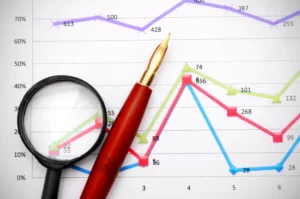Every trader wants the same things: to make better decisions, reduce stress, and trade with greater confidence. Yet in today’s fast-moving markets, where price swings are sharp and news flows nonstop, information overload is one of the biggest challenges. Many traders struggle not because they lack tools but because they rely on emotions instead of clear signals. This is why understanding leading and lagging indicators is so important. These indicators are more than technical analysis tools—they act as a trader’s compass, helping interpret market behaviour, spot opportunities, and avoid costly mistakes.
Leading and lagging indicators can transform a cluttered price chart into a structured action plan. Predictive market indicators, commonly called leading indicators, give traders an early signal of what might happen next. They provide a valuable edge by highlighting possible reversals or breakout setups before the wider market reacts. On the other hand, trend confirmation signals—also known as lagging indicators—validate that a move is real and already underway. They protect traders from false starts and allow them to ride strong trends with greater confidence.
When used together, these tools create a powerful framework for decision-making. Leading indicators help you anticipate market moves, while lagging indicators confirm whether your analysis is correct. This combination not only reduces guesswork but also builds the discipline needed to stick with a strategy.
In this article, we’ll break down exactly how leading and lagging indicators work, why they matter in different market conditions, and how you can combine them to trade smarter. By the end, you’ll know how to cut through the noise, trade with more clarity, and experience less stress in your trading journey.
What Are Leading and Lagging Indicators?
Trading indicators are essential tools that help traders interpret raw price data and uncover patterns that are not immediately visible on charts. They form the backbone of technical analysis, offering insights into both potential future movements and the strength of current market trends. Among these tools, leading and lagging indicators play distinct but complementary roles in shaping trading decisions.
Leading indicators, often called predictive market indicators, are designed to signal potential changes in direction before they actually occur. They attempt to “lead” the price by identifying conditions that may trigger a new trend. For example, oscillators like the Relative Strength Index (RSI) or the Stochastic Oscillator often give early warnings of overbought or oversold conditions. Traders use them to anticipate reversals, allowing entry before the majority of the market reacts. These indicators are especially useful in range-bound markets where timing entry and exit points is critical.
Lagging indicators, by contrast, serve as confirmation tools. They follow price action and only trigger signals once a trend is already established. Moving averages and MACD are classic examples of lagging indicators. Instead of predicting, they validate that the trend is real and not just a temporary price swing. While this means signals come later, it also reduces the risk of reacting to false breakouts or short-lived moves.
Both types of indicators can be applied across asset classes such as forex, stocks, cryptocurrencies, or commodities. The real challenge is not just knowing what each indicator does but understanding when to use it. Successful traders often combine leading and lagging indicators to balance anticipation with confirmation, creating a more reliable trading strategy. When used together in context, these tools can transform uncertainty into confidence and improve consistency in decision-making.
How Leading Indicators Work: The Science of Anticipation
Leading indicators are predictive market indicators that analyse market conditions and anticipate what might happen next. They are perfect for traders who want to spot early opportunities, catch trend reversals, or get a jump on a breakout.
Some of the most popular leading indicators include the Relative Strength Index, Stochastic Oscillator, Commodity Channel Index, Williams %R, and various volume-based tools. For example, RSI measures whether an asset is overbought or oversold. When RSI drops below 30, it tells you selling may be exhausted and a reversal could be on the way. The Stochastic Oscillator looks at where the price closes relative to its recent range and signals potential reversals when readings move below 20 or above 80.
Volume indicators, such as On Balance Volume or volume spikes, are also important predictive market indicators. When volume surges just as price approaches a key support or resistance, it often warns that a big move is coming.
Let’s say you are watching EURUSD and see the RSI below 30, the Stochastic Oscillator in the oversold zone, and a jump in trading volume. These predictive market indicators line up to signal a possible bullish reversal. You prepare to buy as soon as a bullish candlestick pattern appears.
Leading indicators are invaluable for timing entries before a big move starts. However, they can give false signals, especially during strong trends when the market stays overbought or oversold for a long time. That is why experienced traders never use them in isolation.
Lagging Indicators: Trend Confirmation Signals for Reliable Trading
Lagging indicators do not guess. They confirm. These trading indicators smooth out price noise and give you trend confirmation signals once a move is real and established. They allow you to trade with more confidence, knowing that the market is not just making a short-term blip.
Moving averages are classic lagging indicators. When a 50-period Exponential Moving Average crosses above a 200-period EMA, it is a strong signal that the uptrend is real. Moving Average Convergence Divergence goes a step further by comparing two moving averages and signalling shifts in momentum. When the MACD line crosses above its signal line, it is a bullish trend confirmation signal.
The Average Directional Index is another essential tool. ADX measures trend strength. A reading above 25 indicates a strong trend, while readings below 20 signal a weak or sideways market. Parabolic SAR helps manage trades by trailing stop-losses as the trend continues. When the dots flip from above to below the price, it is time to lock in profits.
Imagine a trader waiting for a golden cross, the 50-EMA crossing above the 200-EMA, on Apple stock. The move comes after a long downtrend. The MACD turns bullish, and the ADX rises above 25. These trend confirmation signals all agree, so the trader enters and holds the trade for weeks, riding the full trend.
Lagging indicators work best in trending markets and help you avoid the emotional roller coaster of every price wiggle. You may miss the first part of the move, but you catch the biggest, safest section and avoid being shaken out by short-term volatility.
How to Combine Predictive Market Indicators and Trend Confirmation Signals
The smartest traders rarely use only one type of indicator. The real magic happens when you combine predictive market indicators for early warning and trend confirmation signals for validation. This approach increases accuracy, filters out fake moves, and leads to more consistent results.
Here is a proven routine:
- Scan for setups with leading indicators. For example, look for an oversold RSI and a bullish stochastic oscillator.
- Wait for confirmation with lagging indicators. This could be a moving average crossover, MACD signal, or ADX breaking above 25.
- Enter the trade only when both prediction and confirmation agree.
- Use tools like Parabolic SAR, or ATR, Average True Range, to manage stop-losses and let winners run.
Suppose you are watching Bitcoin. The Stochastic Oscillator shows oversold, the RSI is at 25, and volume spikes on a daily candle. You resist the urge to jump in. Instead, you wait for the 20-EMA to start sloping up and the MACD to cross above the signal line. When all signals align, you buy, capturing the core of the move and reducing stress.
This combination approach works across all markets and timeframes. It creates a rule-based system that keeps you patient and objective.
Real-World Examples: Leading and Lagging Indicators in Action
Let’s explore how real traders apply these technical analysis tools in different environments.
Forex Example
Arjun trades major currency pairs. He spots a volume surge and RSI oversold reading on USDJPY. The Stochastic Oscillator confirms with a bullish crossover. However, Arjun waits for the 20-EMA to turn upward and the MACD to flip positive before buying. By requiring both predictive market indicators and trend confirmation signals, he avoids chasing false breakouts.
Stock Trading Example
Maya trades large-cap stocks. She uses Williams %R to identify when prices are near multi-week lows, hinting at a reversal. After a big earnings miss, CCI also shows extreme oversold. Maya waits for the 50-day SMA to cross above the 200-day SMA and ADX to rise above 25 before entering, ensuring she only joins real, strong trends.
Crypto Example
Vinay trades Ethereum. A sudden spike in volume and oversold RSI catches his attention. But he remembers the lessons of false signals. Only when the MACD crosses up and the parabolic SAR dots flip below the price does he buy in.
Commodities Example
In oil futures, large volume at key support, oversold CCI, and a bullish reversal candlestick set up a trade. The trader enters only after the 10-day EMA turns up and the ADX rises to confirm trend strength.
Strengths and Weaknesses
Leading indicators help you anticipate moves and position early, maximising reward if you are right. But they require discipline because false signals can tempt you into bad trades. Lagging indicators give peace of mind, letting you enter once the crowd has confirmed a trend, but sometimes at the cost of missing the fastest profits.
Understanding the context is everything. Leading indicators shine in ranging or reversal-prone markets. Lagging indicators are best when markets trend strongly. The art is in knowing which to trust when and always using confirmation.
The Psychology of Using Leading and Lagging Indicators
Many traders struggle with impatience and fear of missing out. Leading indicators tempt you to jump in early. Lagging indicators push you to wait for confirmation, but sometimes that means watching the price run without you.
Combining both types of trading indicators brings emotional balance. You feel the excitement of catching big moves and the security of knowing you have real trend confirmation signals before risking your capital. Over time, this reduces emotional mistakes and makes trading more systematic.
Building a Routine: How to Trade Stress-Free
Imagine Deepa, who starts every trading day scanning EURUSD, GBPUSD, and gold charts. She marks setups where predictive market indicators flash oversold, like RSI below 30 and Stochastic under 20. Instead of acting on impulse, Deepa waits for a 20-EMA slope change or a moving average crossover. If MACD turns bullish and ADX confirms trend strength, she enters. Deepa always uses Parabolic SAR to trail stops and never risks more than one percent per trade. This disciplined routine helps her avoid overtrading and keeps stress low, even in volatile conditions.
This is how top traders structure their process. They start with a checklist of predictive market indicators for early setups. They wait for clear trend confirmation signals before entering. They manage trades with trailing stops, not hope. They review performance weekly to adapt indicator settings as markets change.
Advanced Tips: Getting the Most from Your Indicators
Getting the most from leading and lagging indicators means more than simply applying them to your charts. Start by adjusting indicator settings to match your asset and trading style. For example, shorter EMAs such as the 9-period or 14-period work well for day trading and catching quick trends, while swing traders and investors may prefer longer settings like the 50-period or 200-period for greater stability and fewer false signals. Always test and fine-tune these settings in a demo account before relying on them in live markets.
It is also important to pair your trading indicators with classic price action. Check how signals align with support and resistance zones, trendlines, or major chart patterns. When a predictive market indicator suggests a reversal and the price is also hitting a key level, the signal becomes much stronger.
Never ignore fundamental factors. Economic news, central bank announcements, or sudden geopolitical events can invalidate even the strongest technical signals. It is wise to check the economic calendar and be aware of scheduled events before making big decisions.
Always backtest your indicator combinations on historical price data. This shows you how well your predictive market indicators and trend confirmation signals would have worked in various market conditions. A simple, tested system is often more reliable than a complex one.
Lastly, avoid overloading your charts. Two or three well-chosen indicators are usually enough. The goal is clarity and confidence, not confusion.
Avoiding Common Mistakes
Many traders struggle with indicators because they expect them to predict every move. Remember, trading indicators are tools to guide your decision-making, not crystal balls. One common mistake is acting on every predictive market indicator without waiting for trend confirmation signals, which leads to many losing trades. Another is relying on lagging indicators alone and entering too late, missing most of the move.
It is also a mistake to ignore risk management. Even the best technical analysis tools will have losing signals. Always use stop-loss orders and manage your position size to protect your capital.
Adapting your strategy to changing market conditions is vital. What works in trending markets might not work in sideways periods. Review your results, learn from losses, and make adjustments as needed.
Above all, keep your trading system simple, repeatable, and based on sound logic. Consistency will bring you much closer to stress-free success than chasing every new indicator.
The Future of Leading and Lagging Indicators
The world of trading indicators is always evolving. Many traders now combine classic technical analysis tools with new sources of information, such as sentiment data or real-time news feeds. This creates more context for every signal and helps filter out the noise.
As algorithmic and automated trading grow, the principles of predictive market indicators and trend confirmation signals remain essential. Even advanced trading bots use early entry signals for trades and confirmation logic for exits, just like disciplined human traders.
No matter how technology advances, the basics stay the same: use leading indicators to spot opportunities and lagging indicators to confirm them, always in the context of the bigger market picture.
Frequently Asked Questions
Q: Can I use only leading or only lagging indicators?
A: Yes, you technically can use just one type. However, trading with only leading or only lagging indicators can lead to inconsistent results and more second-guessing. Combining both gives you better clarity and reduces stress, since you get the benefit of both early signals and confirmation.
Q: How do I know if my indicators actually work?
A: The most effective way is to backtest your trading strategy. Review months or even years of historical price data, and see how often your predictive market indicators and trend confirmation signals lined up and produced profitable trades. Consistent backtesting results give you more confidence when trading live.
Q: Are these indicators useful for all asset classes?
A: Absolutely. Leading and lagging indicators can be applied to forex, stocks, crypto, indices, and commodities. They help you interpret price action and confirm trends across any liquid market.
Q: Can I automate my strategies with these tools?
A: Yes. Most modern trading platforms allow you to create automated rules for entries and exits based on your preferred indicators. Be sure to test your automated systems thoroughly with demo accounts or on historical data before trading real money.
Q: What should I do if my signals conflict?
A: If your predictive market indicators and trend confirmation signals do not agree, it is best to wait. Patience can save you from many avoidable losses. Only enter trades when both your leading and lagging indicators are in alignment.
Conclusion: Smarter Trading Starts with Balance
Leading and lagging indicators are the foundation of every serious trader’s strategy. Predictive market indicators help you see what’s coming before the majority moves. Trend confirmation signals keep you in sync with real trends, not false moves. Used together, they give you structure, confidence, and clarity.
If you want to reduce stress, avoid emotional mistakes, and achieve more consistent results, start building your own rule-based process. Focus on high-quality signals, stay patient, and let the combination of leading and lagging indicators become your greatest trading advantage.
If you need a checklist or visual template for your charts or want real-life case studies for your market, just ask. Your journey to stress-free, professional trading with leading and lagging indicators begins now.
Read here to learn more about “Margin Trading Guide: How to Trade Safely and Profit in 2025“.

I’m Chaitali Sethi — a seasoned financial writer and strategist specializing in Forex trading, market behavior, and trader psychology. With a deep understanding of global markets and economic trends, I simplify complex financial concepts into clear, actionable insights that empower traders at every level. Whether it’s dissecting winning strategies, breaking down market sentiment, or helping traders build the right mindset, my content bridges the gap between information and implementation.




